Southerly 110
This English-built cruiser is equally at home in the shallows as it is crossing the deep ocean
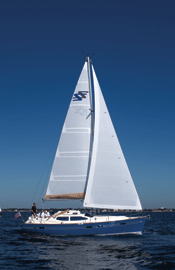 Like every Southerly, the Rob Humphreys-designed 110 blends fresh thinking, quality construction and the unique option of skinny-water sailing or bluewater passage making. And while this handsome 35-foot, 6-inch swing keel, twin-rudder cruiser is now turning heads in North America, sailors on the other side of the Atlantic have long appreciated the innovation that accompanies the introduction of each new Southerly model.
Like every Southerly, the Rob Humphreys-designed 110 blends fresh thinking, quality construction and the unique option of skinny-water sailing or bluewater passage making. And while this handsome 35-foot, 6-inch swing keel, twin-rudder cruiser is now turning heads in North America, sailors on the other side of the Atlantic have long appreciated the innovation that accompanies the introduction of each new Southerly model.
Built by Northshore Yachts Ltd., in Chichester, England, the first swing keel Southerly was launched in 1978. More than 700 boats have been built since then and they've not only proven their mettle as world cruisers, they've also put to rest any questions about the safety of taking a swing keel boat offshore. In addition to the 110, the Southerly line includes the 37-foot 115 and the 135, a robust cruiser with an LOA of 45 feet, 6 inches. There are raised saloon versions of the 110 and 135. Northshore also builds the rugged Fisher pilothouse motorsailers and the traditional, Robert Harris-designed Vancouver series.
I recently had the opportunity to sail the Southerly 110 on Tampa Bay. Although the light breeze and gentle sea state didn't really test the boat, I was impressed with the 110's ease of handling and steady bearing in the water. Within minutes of clearing the dock we had the main and genoa drawing nicely as we eased out of the channel under sail. I was pleased to have John Hiltunen from the factory in England and U.S. dealer David Bagaus aboard.
The details
 The term "swing keel" might be a bit misleading, there is nothing lightweight or small boat-like about the 110's keel arrangement. The keel box, or cavity, is an integral part of the hull and the 4,455 pounds of fixed ballast is cast iron. This section is strong enough for the 110 to dry out in tidal harbors with no adverse effects to the hull and also offers transverse stiffening to the swing keel unit. The 2,310-pound airfoil-shaped swing keel is also cast iron and incorporates a stainless steel pivot at its leading edge. A hydraulic ram, powered by an electric motor, raises and lowers the keel. Naturally there is a manual backup system. The swing keel can actually absorb a shock load better than a fixed foil, and upon impact will retract back into the hull, rotating on its pivot and sparing the boat more serious damage.
The term "swing keel" might be a bit misleading, there is nothing lightweight or small boat-like about the 110's keel arrangement. The keel box, or cavity, is an integral part of the hull and the 4,455 pounds of fixed ballast is cast iron. This section is strong enough for the 110 to dry out in tidal harbors with no adverse effects to the hull and also offers transverse stiffening to the swing keel unit. The 2,310-pound airfoil-shaped swing keel is also cast iron and incorporates a stainless steel pivot at its leading edge. A hydraulic ram, powered by an electric motor, raises and lowers the keel. Naturally there is a manual backup system. The swing keel can actually absorb a shock load better than a fixed foil, and upon impact will retract back into the hull, rotating on its pivot and sparing the boat more serious damage. 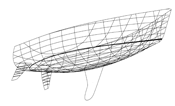
The keel can also be trimmed, by means of a push button at the helm, to various positions. In deep water sailing upwind, the keel is lowered to its full 7-foot, 2-inch length and the 110 tracks like a demon. Off the wind, it can be raised to a more advantageous point. Nosing into a shallow anchorage the keel can be raised completely and the 2-foot, 4-inch draft will certainly be appreciated.
The "other" interesting feature of the 110's underbody is the twin rudder system. Canted on both sides of the gently rounded buttocks, these semi-balanced blades offer excellent steering control. In fact, under most conditions the 110 will steer itself, at least for awhile. And while this doesn't eliminate the need for an autopilot it does mean that the pilot will work less and be more efficient. The rudders are angled to avoid grounding when the 110 is beached or drying out.
The 110's hull is hand laid up fiberglass, solid below the waterline and composite cored from the waterline up. Over the years Northshore has molded hulls for Camper Nicholson, Trintella, Bowman and others-this is the company's specialty. The deck is balsa cored except in areas of high stress loading where plywood is used instead. The hull and deck joint is both chemically and mechanically bonded and covered by a teak caprail. Structural bulkheads are securely fiberglassed to the hull. The boat is solid-it just has the feeling of a 40-footer.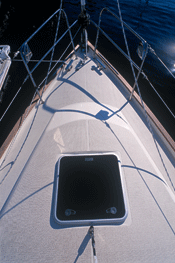
On deck
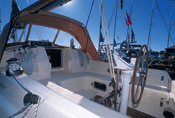 The 110's cockpit is at once comfortable and also designed for offshore work. The helm is positioned well aft and the molded pedestal houses the compass, engine instruments and a single lever throttle control. The Whitlock Cobra system provides smooth steering. The view from the helm is adequate over the relatively high cabintrunk. The primaries are Lewmar 44 STs mounted on the coaming. At first they seem undersized until you remember this is only a 36-foot boat. Sail controls are led aft to rope clutches and Lewmar 16s. Single line slab reefing is standard. The mainsheet features midboom sheeting with much discussed advantages and disadvantages: cockpit space versus boom purchase and loading. Most people choose cockpit space. There are two decent-sized lockers and a deep lazarette to port. European builders tend to tout the open stern not as a swim step but as a simplified means of boarding when Med mooring. Either way it is hard to imagine any new boat with a conventional transom anymore.
The 110's cockpit is at once comfortable and also designed for offshore work. The helm is positioned well aft and the molded pedestal houses the compass, engine instruments and a single lever throttle control. The Whitlock Cobra system provides smooth steering. The view from the helm is adequate over the relatively high cabintrunk. The primaries are Lewmar 44 STs mounted on the coaming. At first they seem undersized until you remember this is only a 36-foot boat. Sail controls are led aft to rope clutches and Lewmar 16s. Single line slab reefing is standard. The mainsheet features midboom sheeting with much discussed advantages and disadvantages: cockpit space versus boom purchase and loading. Most people choose cockpit space. There are two decent-sized lockers and a deep lazarette to port. European builders tend to tout the open stern not as a swim step but as a simplified means of boarding when Med mooring. Either way it is hard to imagine any new boat with a conventional transom anymore.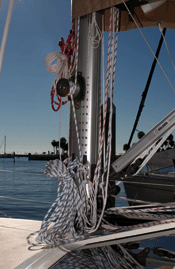

Selden spars are standard and North American sailors should consider the optional tall rig. A solid Selden vang is also standard issue as is Furlex headsail furling gear. The deck gear is first rate, I particularly like the beefy midship cleats for controlling spring and breast lines when coming alongside. A raised bulwark, aggressive nonskid and well-placed stainless grab rails offer security when moving about the deck in seaway. A double, stainless steel anchor roller can accommodate serious ground tackle. The standard anchor is a 33-pound Bruce.
Down below
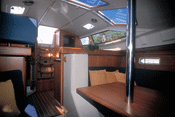 Large saloon windows flood the interior with light and lend a sense of spaciousness. The joinerwork is finished in either solid cherry or cherry-faced plywood and the workmanship is excellent. The interior plan is open, functional and efficient. If this was a multihull or powerboat it would be called a "galley-up plan." Upon dropping below, the galley is to port, and overlooks the saloon. Twin sinks face forward and a two-burner cooker is outboard. There is a lot of counter space and adequate storage in lockers behind the stove and under the sink and in four large draws. An L-shaped full-length stainless rail not only keeps the cook away from hot surfaces but also provides a welcome handhold when preparing meals underway.
Large saloon windows flood the interior with light and lend a sense of spaciousness. The joinerwork is finished in either solid cherry or cherry-faced plywood and the workmanship is excellent. The interior plan is open, functional and efficient. If this was a multihull or powerboat it would be called a "galley-up plan." Upon dropping below, the galley is to port, and overlooks the saloon. Twin sinks face forward and a two-burner cooker is outboard. There is a lot of counter space and adequate storage in lockers behind the stove and under the sink and in four large draws. An L-shaped full-length stainless rail not only keeps the cook away from hot surfaces but also provides a welcome handhold when preparing meals underway. 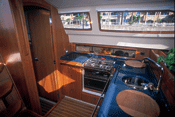 The nav station is opposite the galley and includes a clever instrument console for repeaters. Another stainless railing is well placed to keep the navigator in place and also to keep the crew on their feet as they make their way forward. The electrical panel is located below the chart table, and I know this is a wimpy complaint, but it is a bit uncomfortable to bend down to access the panel. The large head is located aft of the nav station. One head makes sense in a boat of this size. I like the dedicated oilskin locker in the head, which is just next to the companionway.
The nav station is opposite the galley and includes a clever instrument console for repeaters. Another stainless railing is well placed to keep the navigator in place and also to keep the crew on their feet as they make their way forward. The electrical panel is located below the chart table, and I know this is a wimpy complaint, but it is a bit uncomfortable to bend down to access the panel. The large head is located aft of the nav station. One head makes sense in a boat of this size. I like the dedicated oilskin locker in the head, which is just next to the companionway.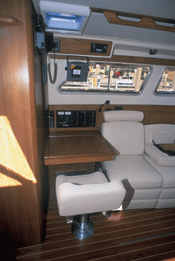
The saloon has a C-shaped dinette to port and a settee and sea berth opposite. There is good storage under the seats, except below the aft end of the dinette where the 45-gallon stainless steel water tank is located. Warm water sailors should consider adding more ventilation in the form of either an overhead hatch in the saloon or opening ports. The forward cabin, which is a bit tight, has a single port berth that converts to a double when necessary. An optional arrangement includes an additional overlapping single berth to starboard. The aft cabin on the other hand is surprisingly spacious. A genuine double berth is offset to starboard with a large vanity and desk to port. Two hanging lockers and a host of drawers and lockers present plenty of storage space. The head can also be accessed from the aft cabin.
There is good access to the engine compartment with hinged panels fore and aft, and in fact the engine box can be completely removed for serious maintenance and repair. A three-cylinder Yanmar 29-horsepower diesel is standard. The 40-gallon stainless steel fuel tank is located below the sole next to the nav station. The Yanmar 3M30 is particularly fuel-efficient and the fixed three-bladed propeller gives the 110 plenty of punch through the water. Without pushing the engine we steamed along at close to 6 knots when we motored back to the dock after our trial.
Under sail
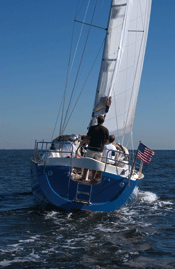 Out on the Bay the wind was fickle. One moment it would fill in at 10 knots apparent and we'd accelerate to 5 knots and then it would falter. Just as advertised the 110 was well balanced and only needed occasional nudges on the wheel to maintain course. We experimented with keel trim and setting the keel couldn't be easier. A lighted control gauge indicating just how much keel is deployed is located on the pedestal. As expected, the 110 tacks much cleaner with the keel down and also tracks up wind better. Whenever we angled off the wind, the keel came up in degrees until when we were running, then it was all the way up. Trimming the keel is simple, just part of the routine and offers a lot of performance pluses.
Out on the Bay the wind was fickle. One moment it would fill in at 10 knots apparent and we'd accelerate to 5 knots and then it would falter. Just as advertised the 110 was well balanced and only needed occasional nudges on the wheel to maintain course. We experimented with keel trim and setting the keel couldn't be easier. A lighted control gauge indicating just how much keel is deployed is located on the pedestal. As expected, the 110 tacks much cleaner with the keel down and also tracks up wind better. Whenever we angled off the wind, the keel came up in degrees until when we were running, then it was all the way up. Trimming the keel is simple, just part of the routine and offers a lot of performance pluses. 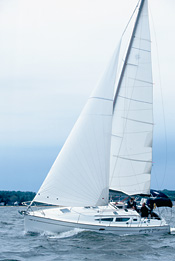
As we glided along John Hiltunen filled me in on the history of Northshore Yachts Ltd., and also told of many notable voyages completed in swing keel Southerlies. And while any boat I own must be bluewater capable, what really had me thinking about the Southerly 110 was all the shallow water in my home waters. I have longed to explore the broad expanse of Florida Bay and nose up into the jungle rivers of Everglades National Park. I have also dreamed of cruising the shimmering flats off the west coast of Andros Island in the Bahamas, but my deep-draft boats have always kept me at arms length from these unspoiled cruising grounds. The Spanish have a proverb that says it's not the length of a man's life that matters, but the width. The Southerly 110 makes a sailor's world a bit wider.
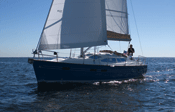

Comments